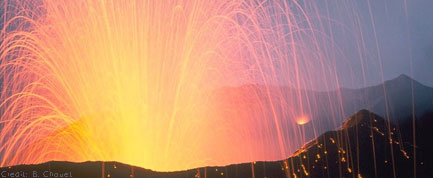Sounds of Volcanic Eruption Recreated

In a high-tech version of those baking soda-and-vinegar experiments at science fairs, scientists have simulated a key stage of volcanic eruptions where steam and other fluids rushing through cracks in underground rocks create particular “acoustic emissions."
The study, detailed in the Oct. 10 issue of the journal Science, could help geologists make better forecasts of volcanic eruptions.
Volcanic eruptions aren't just the lava, ash and other material that spews out of the volcano's mouth; they're also seismic events that shake the ground, just like an earthquake. And this shaking isn't the only seismic event that the eruption creates.
The other kind of seismicity associated with the volcano occurs after the initial shaking, but before the eruption, "when you have fluids and gases moving through the edifice and cracks and fault zones [and] you get this characteristic ringing and a resonance," said study team member Philip Benson of the University College London.
These so-called "low frequency events" are below the range of human hearing, but are detectable by instruments. Because they occur before the actual eruption, they could help predict when a volcano is about to blow.
Geologists have suspected that these low frequency events were created by the fluids interacting with damage zones in the rocks.
"But no one's actually seen these damage zones," Benson told LiveScience.
Sign up for the Live Science daily newsletter now
Get the world’s most fascinating discoveries delivered straight to your inbox.
Scaling down
Benson and his colleagues set out to simulate these events and test theories with a scaled-down experiment in the lab using cylindrical rock cores drilled from Sicily's Mt. Etna.
The rock samples were placed in a chamber that was pressurized to simulate being buried at a depth of 1.5 miles (2.5 kilometers) underground. A piston is used to fracture the rock, to mimic a volcanic tremor.
"The first stage is to create a fault in the sample, and a damage zone," Benson explained. The next step is to decompress the sample.
"The pressure release stimulates rapid fluid movement," Benson said.
The fluid movement produced acoustic emissions just as it would in a real eruption, "but in the laboratory, because we're scaling down the whole process, the frequencies go up, and now it's above human hearing range," Benson explained. "But the physical mechanism responsible for these effects is the same."
Benson's team could then take samples of the rock cores, slice them up, and look at them in a microscope and "pick out the exact spot where these low frequency events occur," Benson said. The team was able to find the undulations and cracks that various theories predicted would be in the rock.
"So this is going to just simply improve our understanding of exactly how these processes occur," and will help volcano forecasters sharpen their forecasting models, Benson said.
- Volcano Quiz, Part 1
- Natural Disasters: Top 10 U.S. Threats
- Images: Wild Volcanoes

Andrea Thompson is an associate editor at Scientific American, where she covers sustainability, energy and the environment. Prior to that, she was a senior writer covering climate science at Climate Central and a reporter and editor at Live Science, where she primarily covered Earth science and the environment. She holds a graduate degree in science health and environmental reporting from New York University, as well as a bachelor of science and and masters of science in atmospheric chemistry from the Georgia Institute of Technology.









